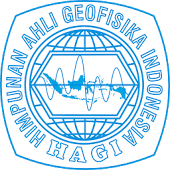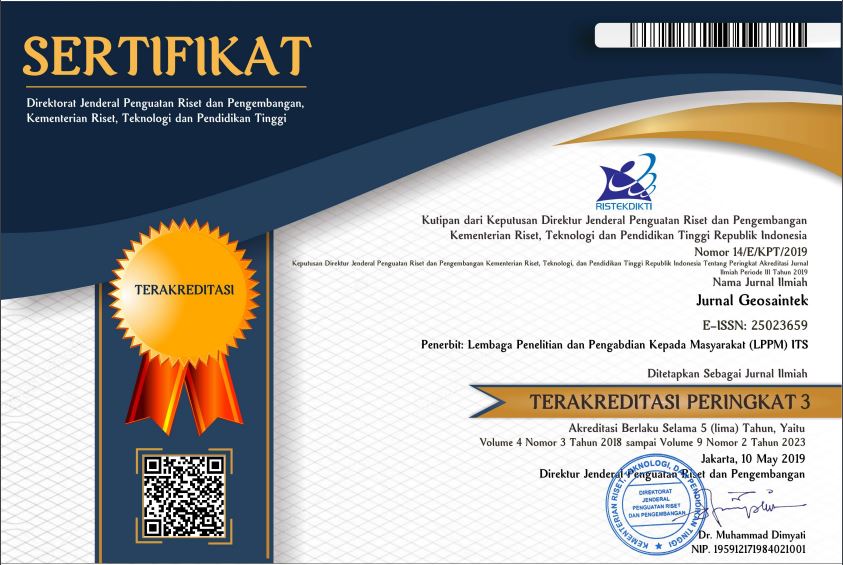IDENTIFIKASI KEMENERUSAN PIPA AIR BAWAH PERMUKAAN MENGGUNAKAN METODE GROUND PENETRATING RADAR (GPR)
Abstract
Metode Ground Penetrating Radar (GPR) merupakan metode geofisika non destruktif yang menghasilkan resolusi tinggi terhadap kontras dielektrik bawah permukaan. Dengan menggunakan metode GPR, penelitian ini dilakukan untuk mengidentifikasi kemenerusan pipa air dan kepadatan lapisan pada daerah “AYE”. Frekuensi alat yang digunakan dalam pengambilan data adalah 270 MHz dengan jumlah lintasan sebanyak dua lintasan dan panjang tiap lintasan 20 m. Pengolahan dilakukan dengan program MATGPR dalam software Matlab 2015a. Tahap yang dilakukan dalam pengolahan antara lain input data, adjust signal position, remove DC component, dewow filter, median filter, inverse amplitude decay, removal global background, karhunen-loeve filter, bandpass filter, resample scan axis, 1-D velocity model, phase-shifting migration, 1D time to depth conversion, dan picking anomaly. Hasil pengolahan diperoleh penampang radargram dengan kedalaman ±7 meter. Dalam penampang radargram tersebut, diketahui dua anomali hiperbola yang sama diduga sebagai kemenerusan pipa air dengan bahan PVC pada meter 11.1 dan 18.1 dengan kedalaman 0,3 meter pada lintasan 1, dan ditemukan pada meter 10.7 dan 18.3 dengan kedalaman 0.9 meter pada lintasan 2. Anomali yang diduga pipa tersebut memiliki rentang kecepatan 0.0171 m/ns hingga 0.138 m/ns. Lapisan yang padat diindikasikan berada di kedalaman >4 meter yang ditunjukkan oleh reflektor dengan horizon yang kurang tajam, sedangkan lapisan bagian atas yang kurang padat diduga sebagai lapisan timbunan
Ground Penetrating Radar (GPR) method is a non destructive geophysical method that produces high resolution of subsurface dielectric contrast. Using the GPR method, this research was conducted to identify the continuity of water pipes and layer density in the "AYE" area. The frequency of the tool used in data collection is 270 MHz with a total of two passes and a length of 20 m for each pass. Processing is done with the MATGPR program in Matlab 2015a software. The stages carried out in the processing include data input, adjust signal position, remove DC component, dewow filter, median filter, inverse amplitude decay, removal global background, karhunen-loeve filter, bandpass filter, resample scan axis, 1D velocity model, phase-shifting migration, 1D time to depth conversion, and anomaly picking. The processing results obtained a radargram cross section with a depth of ±7 meters. In the radargram cross section, the same two hyperbola anomalies are suspected to be the continuation of a water pipe with PVC material at meters 11.1 and 18.1 with a depth of 0.3 meters on track 1, and found at meters 10.7 and 18.3 with a depth of 0.9 meters on track 2. The suspected pipe anomaly has a velocity range of 0.0171 m/ns to 0.138 m/ns. The dense layer is indicated to be at a depth of >4 meters as indicated by the reflector with a less sharp horizon, while the less dense upper layer is suspected to be the fill layerKeywords
GPR; kemenerusan pipa; kontras dielektrik
Full Text:
PDFReferences
Adsura, S.P. and Nur, A.A. (2021), “Analisa Tanah Lunak Menggunakan Metode Standar Penetration Test Dan Ground Penetration Radar”, Bulletin of Scientific Contribution: GEOLOGY, 19(1), pp.1-8.
Arief, M., & Sumargana, L. (2021). Penggunaan Metode Ground Penetrating Radar (GPR) Untuk Identifikasi Utilitas Bawah Tanah. Prisma Fisika, 9(3), 244-248.
Azizah. (2016), “Pemfokusan Citra Radar Untuk Hasil Pemodelan Radar Penembus Permukaan Menggunakan Algoritma Migrasi Jarak”, Jurnal ELKOMIKA, Vol: 4; No:1; Hal:110-122.
Benson, R., and R. Glaccum. 1979. The application on of groundpenetrating radar to soil surveying. Final Report NASA, Cape Kennedy Space Center, FL. Technos, Inc., Miami, FL.
Beres, M., and Haeni, F. P. (1991). Application of groundpenetrating-radar methods in hydrogeologic studies. Ground Water, 29(3), 375-386.
Elfaraby, W. A., & Syaifudin, F. (2017). Pengolahan data Ground Penetrating Radar (GPR) dengan menggunakan software MATGPR R-3.5. Jurnal Teknik ITS, 6.
Fiqriawan, M.R. (2023), “Pemanfaatan Metode Georadar dalam Menganalisis Lapisan Tanah di Indonesia”, Einstein's: Research Journal of Applied Physics, 1(2), pp.38-41.
Mohd Kamal, N. H. B., Amin, Z. M., & Mohamad, N. B. (2020), “The Effect of Ground Penetrating Radar (GPR) Image Reflection on Different Pipes and Soil”, IOP Conference Series: Earth and Environmental Science, 540(1). https://doi.org/10.1088/1755-1315/540/1/012093
Musset, A.E. and Khan, M.A. (1993). Looking into the Earth: An Introduction to Geological Geophysics. London: Cambridge University Press.
Pramudhita, B. D. P. A., Yusroni, S. A., Wafi, A., Setiawan, N. S., Santoso, S. B., & Mariyanto, M. (2021). Georadar method for detecting underground septic tank. Journal of Physics: Conference Series (Vol. 1825, No. 1, p. 012020). IOP Publishing.
Putranto, P. A., & Iskandarsyah, I. (2021). Identifikasi Morfologi Sungai Masa Lampau dan Kaitannya dengan Banjir Masa Lampau Menggunakan Metode Ground Penetrating Radar (GPR) di Daerah Aliran Sungai Citarum, Bandung, Jawa Barat. Prosiding Industrial Research Workshop and National Seminar, 4–5. https://jurnal.polban.ac.id/ojs-3.1.2/proceeding/article/view/2804/2195
Syukri, Muhammad. (2020), Pengantar Geofisika, Aceh: Syiah Kuala University Press. (https://Unsyiahpress.Id/Pengantar-geofisika/ )
Reynolds, J.M. (1997), An Introduction to Applied and Environmental Geophysics, Chichester: John Wiley and Sons Ltd. 796p.
DOI: http://dx.doi.org/10.12962%2Fj25023659.v10i1.19187
Refbacks
- There are currently no refbacks.

Jurnal Geosaintek diterbitkan oleh ITS bekerja sama dengan Himpunan Ahli Geofisika Indonesia (HAGI)
Disebarluaskan di bawah Lisensi Creative Commons Atribusi-BerbagiSerupa 4.0 Internasional.
Berdasarkan ciptaan pada https://iptek.its.ac.id/index.php/geosaintek/index.





